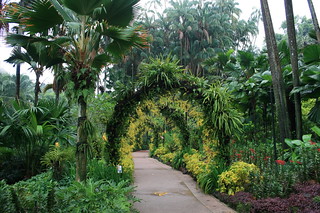| English: unidentified plant in Singapore Botanical Garden (Photo credit: Wikipedia) |
| Dawn crepuscule in the Singapore Botanical Gardens (Photo credit: Wikipedia) |
| orchid (Singapore botanical gardens) (Photo credit: Wikipedia) |
| Singapore Botanical gardens (Photo credit: j0055) |
| Singapore Botanical Garden (Photo credit: Wikipedia) |
-----
And as if to say, health can't be bought, nature comes to the rescue - abundant, free, natural... and it just doesn't soothe tired eyes, but green, leafy scenery soothe tired brains as well...
-----
by Gretchen Reynolds
Scientists have known for some time that the human brain's ability to stay calm and focused is limited and can be overwhelmed by the noise and hectic demands of city living, sometimes resulting in a condition informally known as brain fatigue. With brain fatigue, you are easily distracted, forgetful and mentally flighty.
But a new study from Scotland suggests you can ease brain fatigue by simply strolling through a leafy park.
Researchers have long theorized that green spaces are calming, requiring less of our directed mental attention that urban streets do. Instead, natural settings invoke "soft fascination," a term for quiet contemplation, during which the brain can reset overstretched resources of attention and reduce mental fatigue.
But this theory has been difficult to put to the test. Previous studies have found that people who live near trees and parks have lower levels of cortisol, a stress hormone, in their saliva than whose who live primarily amid concrete, and that children with attention deficits tend to concentrate and perform better on cognitive tests after walking through parks. Scientists have studied volunteers and found that brain wave readouts show that the volunteers are more calm when they view natural scenes.
But it had not been possible to study the brains of people while they were actually outside until the recent development of a lightweight, portable version of the electroencephalogram, a technology that studies brain wave patterns.
For the new study, published in March in The British Journal of Sports Medicine, researchers at Heriot-Watt University in Edinburgh and the University of Edinburgh attached these new, portable EEGs to the scalps of 12 healthy young adults. The electrodes sent brain wave readings wirelessly to a laptop carried in a backpack by each volunteer.
----------
Essential body renewal
----------
The researchers then sent the participants on a short walk throguh Edinburgh, first through a historic district, then through a parklike setting and finally through a commercial district. Afterward, the researchers looked for wave patterns that they felt were related to measures of frustration, directed attention, mental arousal and meditativeness or calm. What they found confirmed the idea that green spaces lessen brain fatigue: in the commercial area their brain waves were aroused; in the park the readings became more meditative.
The study was small, more of a trial study of the new EEG technology than a definitive examination of the cognitive effects of seeing green.
But even so, said Jenny Roe, a lecturer at Heriot-Watt who oversaw the study, the findings were consistent, strong and valuable. The study suggests that, right about now, you should consider "taking a break from work," Dr. Roe said, and "going for a walk in a green space or just sitting, or even viewing green spaces from your office window." This is not a waste of time, Dr. Roe said. "It is likely to have a restorative effect and help with attention fatigue and stress recovery."
-----
Taken from TODAY Saturday Edition, 13-April-2013















No comments:
Post a Comment